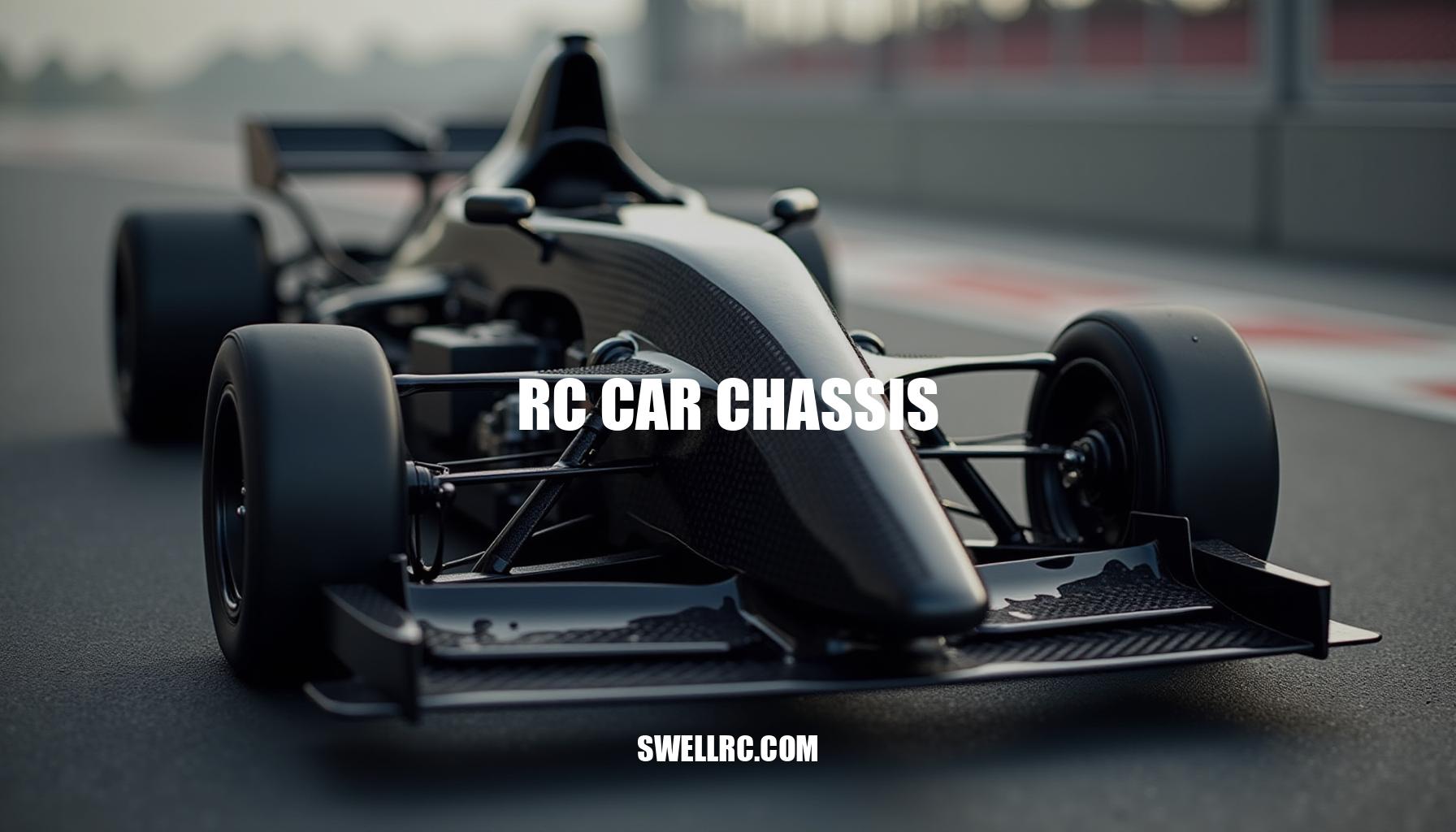Mastering Your RC Car Chassis: The Key to Unleashing Performance
The first time I swapped a flimsy plastic tub for a carbon plate and moved the battery 10 mm forward, my lap times dropped—and my brain lit up. That was the moment I realized the chassis isn’t just a slab under the car; it’s the foundation that dictates balance, durability, and how every component works together. An RC car chassis, often referred to as the RC car frame, serves as the structural backbone for mounting the drivetrain, suspension, steering, battery, and electronics, while critically setting weight distribution and stiffness.
Mastering RC engineering principles is key to optimizing this performance foundation. In the world of hobby-grade RC and remote control vehicles, choosing the right chassis impacts not only speed but also handling and longevity. Whether you’re modifying RC models for off-road adventures or high-speed track runs, understanding chassis balance and material choices empowers you to build with confidence and tune your setup according to your terrain and driving style.
What the RC Car Chassis Actually Does — More Than a Frame
Think of the RC chassis setup as the athlete’s skeleton: it supports the load, transmits forces, and protects vital organs. In RC terms, this means it mounts the motor, servo, and suspension components while managing weight distribution front-to-rear and left-to-right. That balance is crucial because it controls turn-in, mid-corner grip, and stability when applying power.
Additionally, the chassis shields sensitive electronics—especially custom bits like an RC circuit board (learn more here)—from debris and impacts, providing essential component protection and reliable electronics housing.
A well-designed chassis combines structural rigidity to resist unwanted twist where precision is needed, alongside controlled flex to maximize traction. The RC car underbody often includes skid plates and other protective elements to defend against rough terrain, while an adjustable chassis plate allows fine-tuning of handling characteristics.
For a complete picture of how all parts integrate, consider this simple table outlining the primary chassis components and their functions:
| Chassis Part | Function |
|---|---|
| Chassis Plate | Central frame piece supporting all major components; key in weight distribution and overall rigidity. |
| Upper Deck | Provides additional structural support and mounting points for electronics and body. |
| Braces | Reinforce chassis strength to reduce unwanted flex, enhancing structural rigidity. |
| Bulkheads | Anchor points for suspension and drivetrain components, ensuring alignment and durability. |
| Skid/Underbody Protection | Shields the chassis from rough terrain and impacts, preserving RC car underbody integrity. |
| Battery Tray | Secure and protect battery pack; crucial for maintaining low center of gravity and balanced weight. |
| Servo Mount | Fixed location for steering servo to ensure accurate and responsive control. |
| Mounting Points for Suspension and Drivetrain | Connection hubs for suspension arms and drivetrain parts, affecting handling and power delivery. |
Materials That Shape Performance — Comparing RC Chassis Types
Material choice changes everything in your RC car setup—from weight, flex, and durability to cost and even the car’s feel over bumps. After extensive testing of various lightweight RC car chassis options, here’s what I’ve found:
- Plastic tub chassis: Affordable and forgiving, making them ideal for off-road bashing and beginners due to excellent vibration damping and crash resilience.
- Aluminum RC chassis: Tough and precise, offering high torsional stiffness but coming with added weight. Perfect for racers who prioritize durability vs weight and want consistent handling.
- Carbon fiber chassis: Ultra-light and stiff, delivering razor-sharp response, perfect for on-road racing and professional setups where performance is critical.
- FRP chassis (fiberglass): Splits the difference well for budget-conscious builders seeking a balance of durability and weight.
In high-end professional RC cars (see professional RC cars), you’ll often find carbon plates reinforced with tuned braces to achieve consistent handling characteristics. Also, don’t overlook how the body shell material interacts with the chassis; the shell contributes both aerodynamic benefits and protection while its flexibility and weight complement the chassis choice.
| Material | Weight | Torsional Stiffness | Crash Resilience | Vibration Damping | Price | Best Use Cases |
|---|---|---|---|---|---|---|
| Plastic Tub Chassis | Low | Low | High | High | Low | Off-road bashing, beginners |
| Aluminum RC Chassis | Medium-High | High | High | Medium | Medium | Mixed surfaces, durability-focused racing |
| Carbon Fiber Chassis | Very Low | Very High | Low-Medium | Low | High | On-road racing, professional use |
| FRP (Fiberglass) Chassis | Medium | Medium | Medium | Medium | Low-Medium | Budget builds, mixed use |
My tip: prioritize predictable flex and parts availability. Don’t chase the absolute lightest setup unless you’re aiming for podiums. The right best materials for RC car chassis often balance durability vs weight while providing the right feel through vibration damping.
Building and Customizing Your Own RC Car Chassis
When embarking on building your own DIY RC frame, you have options like fabricating from G10/FRP or carbon sheets or opting for modular chassis kits that allow you to tweak designs as you gain experience. If you choose fabrication, begin by carefully mapping out crucial parameters such as wheelbase planning, track width, and compatibility and mounting hole locations to ensure precision.
The fabrication process should follow key steps:
- Rough-cutting the material to size
- Drilling mounting holes accurately
- Chamfering edges to prevent stress risers
- Sealing edges to protect against moisture and abrasion
A comprehensive guide on the construction process can be found in the tutorial how to build a RC car frame. For those who prefer not to start from scratch, exploring buildable RC cars offers access to pre-aligned parts and clear upgrade paths—check out options at buildable RC cars.
Scalability is essential in your RC car projects.
For instance, I’ve fine-tuned tiny platform kits like Hexmods RC, perfect for tight indoor tracks, then scaled the same design principles to more competitive 1/10 scale racers (Hexmods RC). Through testing various configurations, I’ve found that battery tray placement and brace layout yield the most significant improvements in handling for the time invested.
Always observe safety precautions: wear eye protection when cutting carbon fiber, ensure precise drilling, and perform thorough test-fitting before final assembly to avoid costly mistakes.
Optimizing Chassis for Performance — Tuning, Weight, and Terrain
RC chassis tuning is where the car truly comes alive, offering a tangible difference in speed and control across diverse terrain. When considering on-road vs off-road RC chassis, the setups vary significantly; on-road tuning typically involves lowering the ride height, stiffening the decks, and centralizing mass to sharpen steering precision and boost stability at high speeds. Conversely, an off-road RC frame benefits from increased flex to enhance mechanical grip and provide greater forgiveness when navigating ruts and uneven surfaces.
For enthusiasts building big tires and long-travel suspensions, this guide to making an RC monster truck brilliantly illustrates how chassis geometry and shock towers scale accordingly. Practical tuning adjustments I’ve logged include:
- Moving the battery a few millimeters to optimize weight placement and improve the center of gravity
- Shifting the ESC/receiver to fine-tune cross-weight balance
- Swapping top-deck braces to adjust chassis flex for terrain-specific handling
To precisely evaluate each modification, validate changes on an RC car race track, allowing you to isolate variables like camber, toe, caster, and droop. For hobbyists on a budget, focus your initial efforts on optimizing weight distribution and selecting the right tires, a strategy harmoniously supported by recommendations from cheap RC cars that go fast. With the right terrain-specific setup, even affordable builds can deliver exceptional performance.
Conclusion — The Foundation of Every Great RC Build
Master the chassis and everything else becomes easier: the car communicates more clearly, parts last longer, and your tuning changes make sense. Materials set the character; layout and braces sculpt the feel; weight placement finishes the recipe. My journey started with one plate swap and a battery nudge—and I’ve been chasing that “ah-ha” feeling ever since.
Consistent chassis tuning checklist practices are the backbone of successful hobby-grade RC progression, helping you understand the essential handling fundamentals of your vehicle. Proper RC maintenance routines not only improve performance but also prolong the life of your components, making your upgrade planning methodical and effective.
Keep experimenting and document changes carefully; this enhances setup repeatability, letting you build a car that feels purpose-built for you. To help guide your process, here’s a quick checklist table for tuning essentials:
| Tuning Step | Purpose |
|---|---|
| Verify straightness | Ensure chassis and components are aligned for predictable handling. |
| Set ride height | Optimize ground clearance for traction and stability. |
| Set droop | Control suspension articulation, affecting grip and responsiveness. |
| Balance weights | Distribute mass evenly to enhance cornering and acceleration. |
| Torque screws evenly | Prevent chassis warping and maintain structural integrity. |
| Confirm no chassis rub | Avoid friction points that can degrade performance and components. |
| Test one change at a time | Isolate effects to understand each tuning adjustment clearly. |
Frequently Asked Questions
- What is the purpose of a chassis in an RC car?
It’s the structural backbone that mounts and aligns all components, sets weight distribution and stiffness, protects electronics, and ultimately defines how the car handles, accelerates, and survives impacts. - What materials are most common for RC car chassis designs?
Plastic/nylon tubs for budget and durability, FRP for value, aluminum for toughness and precision, and carbon fiber for the lightest, stiffest racing performance. - How does chassis weight affect RC car performance?
Lower weight generally improves acceleration and responsiveness, but too light can reduce stability and traction on rough surfaces. Balance mass with appropriate stiffness and damping for your terrain. - Can you build your own RC car chassis from scratch?
Yes. With basic tools you can cut and drill G10/FRP or carbon plates. Careful planning of wheelbase, mounting points, and bracing is key; test-fit components before final assembly. - What’s the difference between a professional RC chassis and a hobby-grade one?
Pro chassis emphasize low weight, tuned flex, precision geometry, and adjustability; hobby-grade options prioritize durability, simplicity, and cost while offering fewer fine-tuning features. - Are there buildable RC chassis kits for beginners?
Absolutely. Beginner-friendly kits provide pre-aligned parts and clear instructions, letting you learn fundamentals and upgrade components as your skills grow. - How do you maintain and upgrade an RC car chassis?
Regularly check straightness, tighten fasteners evenly, inspect for cracks or bent parts, clean debris from the underbody, refresh bearings, and upgrade braces, plates, or mounts to match your performance goals.



